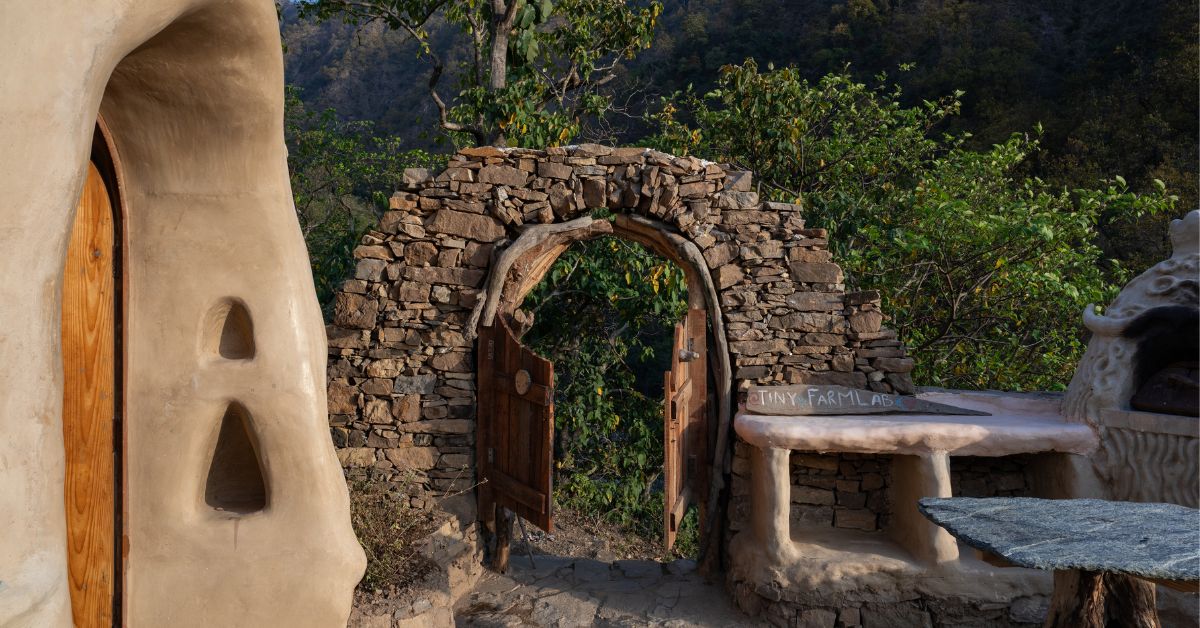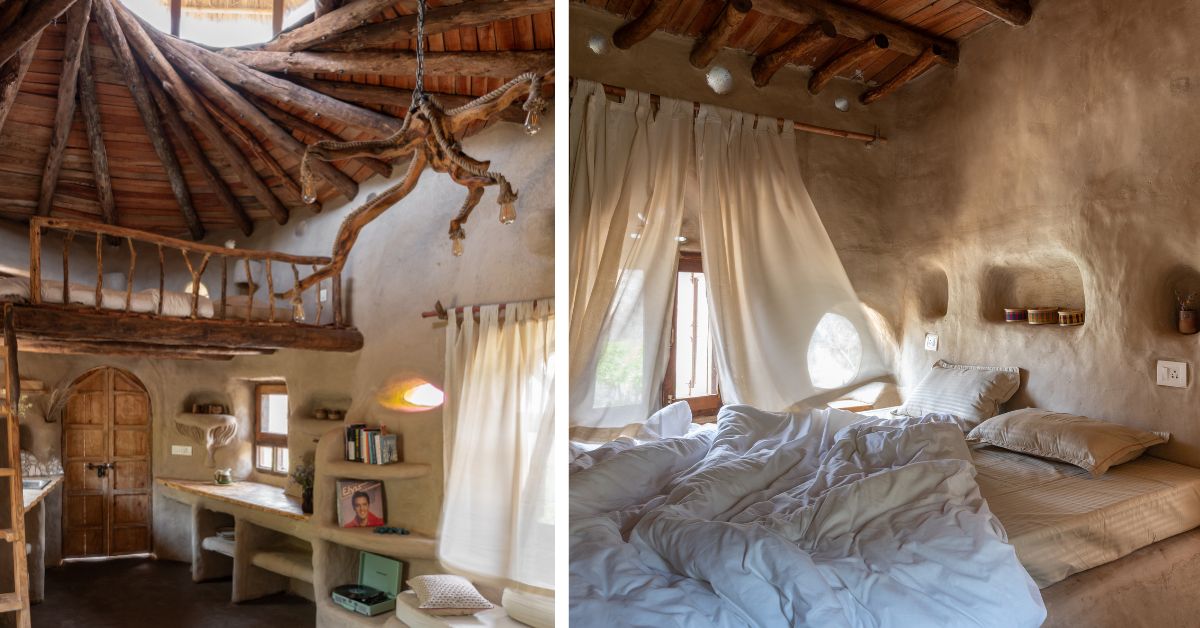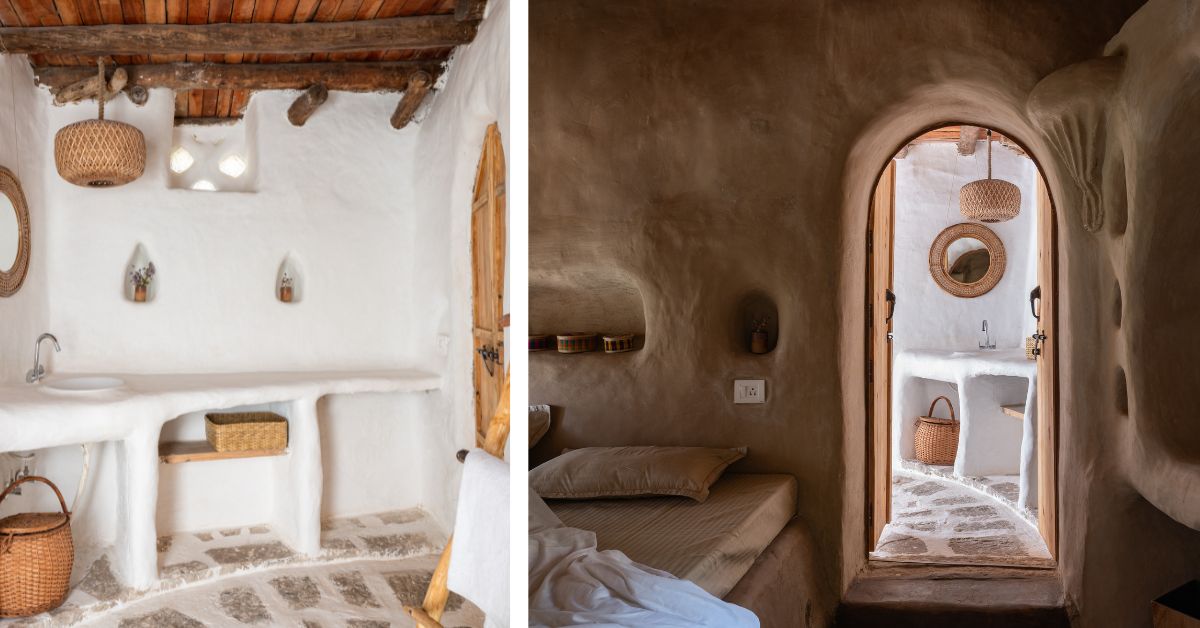“What do you mean it’s not a replica of Hagrid’s house?” I ask Raghav Kumar (30), one half of the brother duo that has conceptualised a 600-sq ft beauty in the heartland of Rishikesh, Uttarakhand. As fans of the seven-part fantasy series ‘Harry Potter’ will immediately guess, I’m referring to the eight-foot-tall giant Rubeus Hagrid’s cabin on the edge of The Forbidden Forest — an ominous wood filled with wizarding creatures.
Cosy fires, larger-than-life teacups, and a drooling boarhound Fang filled most evenings that Harry and his friends spent at Hagrid’s. I often found myself craving to be there.
My wish might just have been answered.
Raghav and Ansh’s ‘Tiny Farm Fort’ is reminiscent of Hagrid’s abode. Creating the 15-ft doppelganger homestay, the brothers say, wasn’t the goal that backed their transition from their city life in Delhi to the mountains in 2021. Instead, it was a consequence of it.
Both architects, Raghav and Ansh (27) were keen on living an “intentional life closer to nature” — a dream they felt couldn’t be achieved by being a part of modern corporate architectural projects that prized demand over sustainability.
“There was a disconnect between the architect and the labour involved in these projects. There was a lot of greenwashing,” Raghav notes. Prior to 2021, the Delhi-based boys had their week cut out for them — weekdays spent working long hours and weekends trekking to North India.
The seed for Tiny Farm Fort was sown when, after one particular trek to Rishikesh in December 2020, Raghav and Ansh found themselves wishing they could stay back in the mountains and not return to the monotonous hustle. And they decided to do just that.
Once completely bewildered by topics of gardening and a rural lifestyle, the journey of building Tiny Farm Fort has stretched their understanding in these regards.
Today, they invite us into their home.


Knock on sustainability
Anyone who passed by Dhunar Gaon in Rishikesh in 2021, was met with an unusual sight. Albanian folk songs reverberated through the air, interrupted only by the beats of Japanese rock music, German techno, and Daler Mehndi’s ‘Tunak Tunak Tun’.
And grooving to these lively tempos were a group of 90 individuals. A closer look at them would reveal their vivid origins — Brazil, Australia, Germany, France, Canada, Slovenia — 18 nationalities, to be precise, Ansh states. Their rhythms though unchoreographed, would seem almost synced to an onlooker.
But don’t be distracted by their moves, Ansh urges, look under their feet instead.
Elaborating on the material the group spent months dancing upon, he says, “Cob is a mixture of clay, sand, soil, straw and water. We chopped wheat and rice straw, put it on a tarp, and then invited the group to dance on it until it formed a burrito-shaped dough. Once stable, the dough does not break and can be used as a building material.”
Explaining how they brought in foreign hands for the project, Raghav laughs and says, “It wasn’t planned. We put out a request on the website ‘Workaway’, asking people interested in sustainable building to join us. Through the months, we got many who were keen on this.”
He adds that these were people who did not specially make a trip to dance on the cob. “They were already heading to Rishikesh for a vacation. But their interest in natural building attracted them to our site. We set up a dorm for them in the village Umrisen, where we were camping out during the construction.”
Aishwarya Lakhani, an interior designer from Mumbai, who was a part of this community effort, says she had always been meaning to get into conscious design. “When I came across this project, I saw an opportunity. I had been wanting to go to Tiny Farm Lab for months and since it was coinciding with my Rishikesh travel dates, I decided to head there. Right from day one, it was a warm experience staying with the villagers. Raghav and Ansh took good care of us.”
She echoes the thoughts of the others when she says, “We were in awe that such a thing could be achieved in a remote location. Having practised with reusable materials and natural plasters myself, it [this project] gave me hope and inspiration knowing that the sky is the limit when using cob for built environments. Working with cob grounds you. Dancing on the mud is an emotion.”
Bharat Rolaniya, an architect, seconds Lakhani. “Working with mud, specifically cob was very intuitive to me. Being a natural building construction practitioner, I enjoyed working with cob. It’s almost like finding yourself. In architecture, one tends to feel like they are transforming a building, but working with mud and cob shows you that it goes both ways — they transform you in turn,” he says.
It took the brother duo three years to build Tiny Farm Fort. They recall the journey as revelationary in many ways.
“For two city kids who did not know much, we learnt a lot,” says Ansh. “Travelling from the last motorable point in Phoolchatti to the Umrisen village involved crossing a wooden bridge across a tributary Heval and then hiking for 1.5 km. Each time we had to get groceries, we had to make a 20 km trek.” But the effort was worthwhile.


Today, Tiny Farm Fort is a masterpiece. “And a work of many hands,” points out Raghav. “We used to spend almost six to eight hours building the home and never took a day off. Whether it was hot sun with temperatures crossing 44 degrees Celsius, raining, or even dark and cold in winter — nothing stopped us.”
To add to it, it wasn’t easy being outsiders in a village. But instead of resisting guidance, Raghav says, “We let the villagers take over.” And as the brothers soon realised, there was a lot of wisdom to be gleaned.
“We let them teach us farming, how to use tools for construction, how to pick up rocks, break them, and then build a frugal trolley to transport these rocks, bamboo and wooden logs back and forth. We learnt how to make rotis (Indian flatbread) using a chula (earthen stove),” he adds.
Finally, in 2024, Tiny Farm Fort was ready to host its first guests.
If you’re planning to make a trip here, full disclosure: reaching the homestay from Heval involves a 30-minute trek, with some pockets posing a steep climb. But the beauty compensates for it.
As you set foot into Tiny Farm Fort, deja vu will creep up on you, making all those fairy tales seem believable at long last. In every sense, Tiny Farm Fort impersonates a goblin’s den, and you might almost expect to see one hanging around during your stay.
The homestay is cradled by a mountain forest and perched high on a ridge such that it overlooks an expanse of emerald — the waters of the river Ganges.
A coolness engulfs the home in the summers, while an ambient temperature is maintained during the winters — gratis the 19-inch thick mud walls. As Raghav and Ansh iterate, the home was designed with an open plan in mind with a cosy loft bed and a cave-like bedroom (which accommodates two people each), a kitchenette with pots and pans, an outdoor barbeque, a woodfire pizza oven — made completely from mud — a rooftop garden, and a sensory bathroom.

The devil is in the details. From a table made using discarded slate from an old home’s roof and a chandelier crafted from driftwood from the river Ganges, each piece of decor is a sustainable rendition.
The food served is unique too — a simple meal of aloo sabzi (potato vegetable), roti, and dal (a dish made of lentils). When you aren’t feasting (your mouth) on the home-made fiestas and (your eyes) on the view, you can take part in a rafting session on the river Ganges; or go bird watching to spot the White-crested Himalayan Forest Laughing Thrush or the Red-billed Blue Magpie; or learn to brew kombucha (a fizzy fermented drink); or go foraging for mushrooms.
Somedays, the weather might play spoilsport, but dark skies are no deterrent to the mood at Tiny Farm Fort. Candlelit dinners and torches come to the rescue. Applaud Raghav and Ansh for this work of art and they say it is the material ‘cob’ that is the real hero. When pitted against other sustainable materials, cob emerges a winner for its durability and beauty, all tied into one.
And the Tiny Farm Lab is where these ideas are born.
A space where artistry meets sustainability
A circular design, research, build, and innovation studio in the woods in Rishikesh, Tiny Farm Lab is attempting to reinstill people’s beliefs in materials that were used centuries ago.
“Especially materials whose desirability has gone down,” Ansh adds. With a focus on biobased materials, such as mycelium (a root-like structure of a fungus), seaweed bioplastic and mud, the studio is an ode to how the best architecture is born out of the simplest ideas. “We wanted to showcase that in a world where everything is fast — fast food, fast deliveries, speed dating — we can build something slow,” Raghav shares.
For instance, take mud.

Once dismissed as kaccha (raw), mud homes are now starting to see an upswing in architecture. “Mud was known as a material that could survive the test of time. But then cases began emerging where the foundation wasn’t strong and water began entering the structure. Slowly, the material lost popularity and cement came in.”
Raghav does not have a bone to pick with the material in itself, but rather with how it has become a status symbol. “Cement is often referred to as masala by Indian labourers — pointing to how its use should be moderated,” Raghav notes. “An overuse can be toxic. It makes the structure non-breathable.”
When it came to Tiny Farm Fort, the brothers decided to use cob as the material. While vetting its feasibility, they relied on an old English saying: A cob house which has a good boot (good foundation) and good hat (roof with large overhangs) will survive a hundred years.
To this end, the strategic location of the homestay proves a boon. “Tiny Farm Fort is perched on a hill and gets good sunlight. In cases of heavy rainfall, the water runs down the valley,” says Raghav.
Not just its exterior, but even the interiors in the home are reflective of sustainable design. For this, the brothers credit the group that chipped in to help them build the homestay. “They weren’t artists, but cob is such a forgiving material to work with that the process almost becomes intuitive,” adds Ansh.
Today their creations and sculptures — elephants, mushrooms, coral life — live on the shelves of Tiny Farm Fort. Ansh adds, “We see this house as a museum where we exhibit products and materials of different designers working with waste or biodegradable biomaterials.” You can take a look when you are here.
With beauty in each nook and crevice, Tiny Farm Fort is a breathing fairytale. Knock once. Who knows, Goldilocks might open the door.
Edited by Pranita Bhat
No comments:
Post a Comment